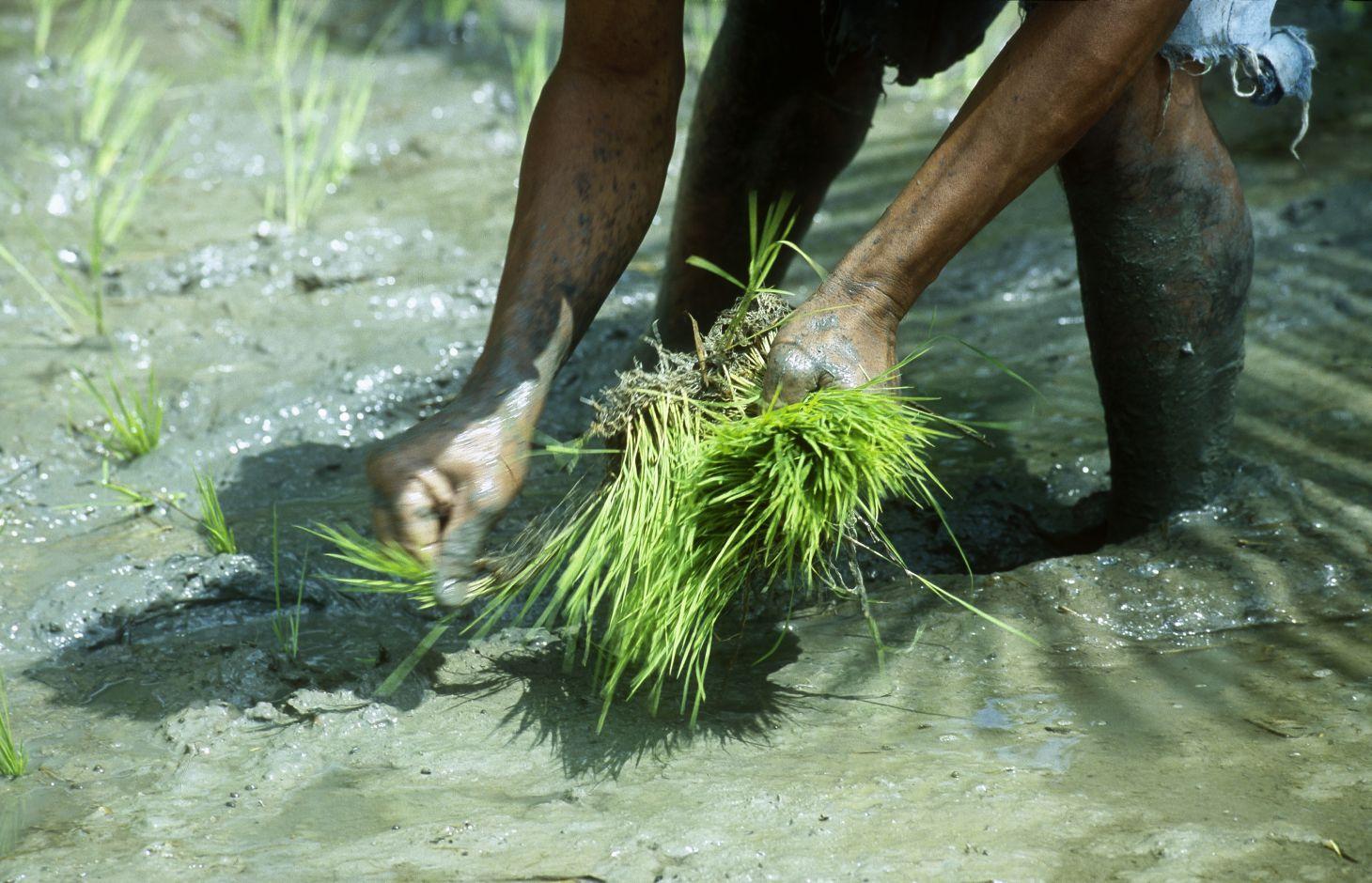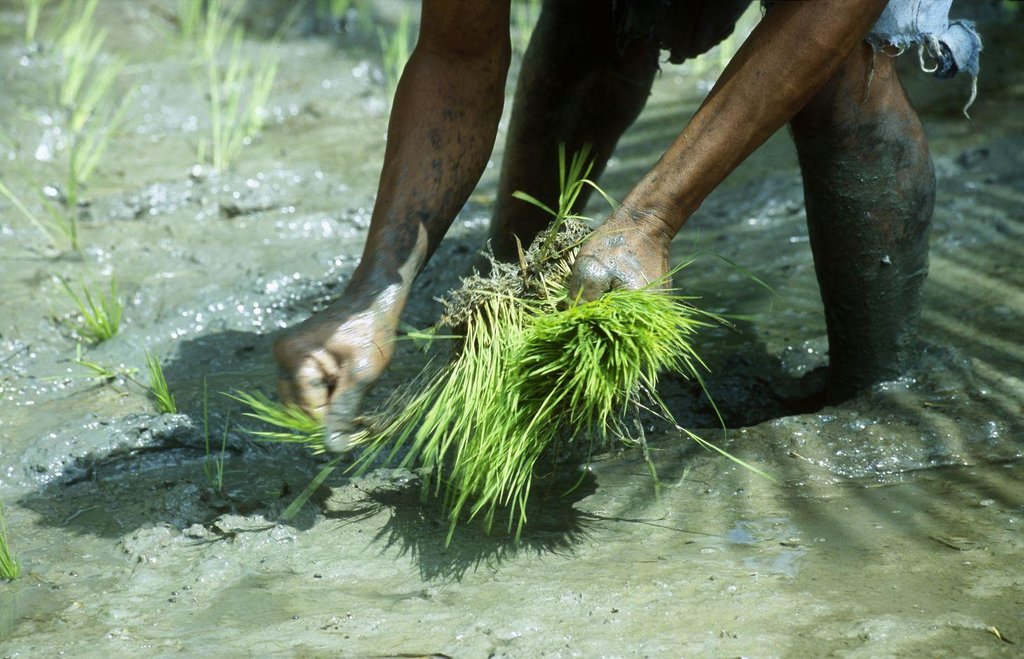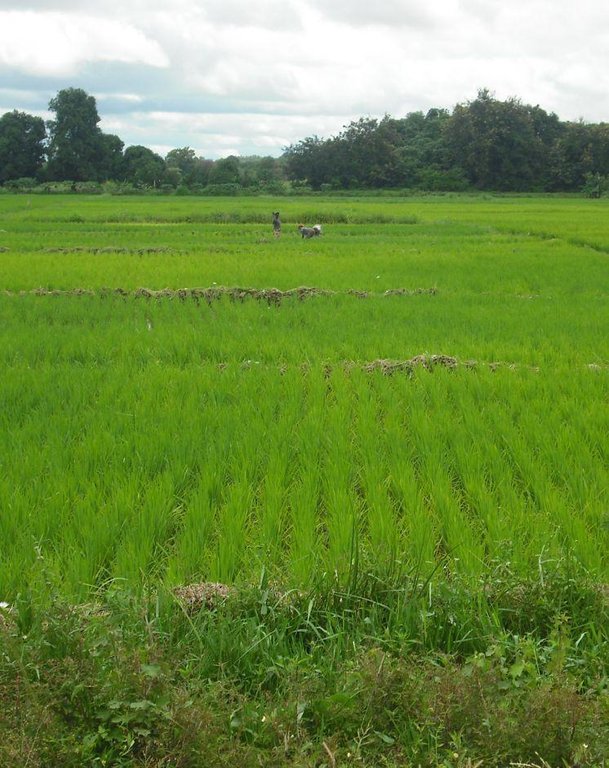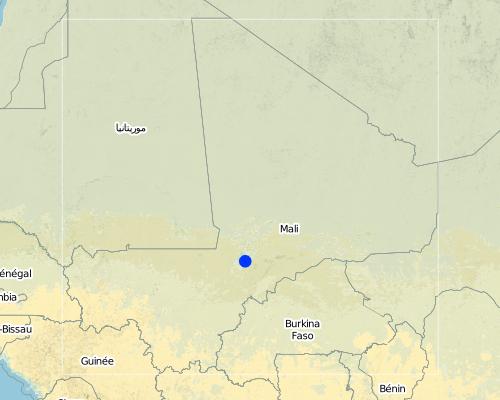System of rice intensification (SRI) [马里]
- 创建:
- 更新:
- 编制者: Dieter Nill
- 编辑者: –
- 审查者: Deborah Niggli
Système de riziculture intensification (French)
technologies_1654 - 马里
查看章节
全部展开 全部收起1. 一般信息
1.2 参与该技术评估和文件编制的资源人员和机构的联系方式
SLM专业人员:
Kouyate Djiguiba
IICEM
SLM专业人员:
Traore Minamba
tbaminan@gmail.com
IICEM
有助于对技术进行记录/评估的机构名称(如相关)
Deutsche Gesellschaft für Internationale Zusammenarbeit (GIZ) GmbH (GIZ) - 德国有助于对技术进行记录/评估的机构名称(如相关)
Intgrated Initiative for Economic Growth in Mali (IICEM) - 马里1.3 关于使用通过WOCAT记录的数据的条件
(现场)数据是什么时候汇编的?:
01/07/2012
编制者和关键资源人员接受有关使用通过WOCAT记录数据的条件。:
是
1.4 所述技术的可持续性声明
这里所描述的技术在土地退化方面是否存在问题,导致无法被认为是一种可持续的土地管理技术?:
否
2. SLM技术的说明
2.1 技术简介
技术定义:
The objective of a system of rice intensification (SRI) is increased yields.
2.2 技术的详细说明
说明:
This can be achieved when rice plants are provided with sufficient air and space for their ripening process. Irrigation water supply requirements are lower, which means the approach can be deployed in low-rainfall areas or the rice growing areas can be extended using the same quantity of water (climate change adaptation). The technique requires less seed and fertiliser.
SRI optimises the soil-water-plant relationship. It increases the plants’ potential for production by correcting disadvantageous practices. In practical terms, this involves growing rice on lowlands and plains using fewer seeds (with the rice variety selected according to the water regime) and less fertiliser.
The system of rice intensification proves that rice is not strictly speaking an aquatic crop. Rice growing simply requires a very humid environment. The water level is maintained considerably lower down the rice stalk than it is in traditional rice paddies, where water levels range from 10 to 25 centimetres.
SRI makes it possible to increase yields by around 35% compared to average yields. It has been possible to cut costs given the shorter growing season (90 days). Growers reduce seed use by 8 to 10 kilograms per hectare. Water use drops by around 35%, given that the rice is not constantly submerged and water levels in the paddy are low.
Implementation: Firstly, the growers are sensitised and informed about the principles and benefits of SRI in terms of yields and production costs, and are given the opportunity to sign up for technical training in SRI. IICEM takes charge of monitoring the proper application of the SRI methods over the
growing season. Seedlings are planted out individually to ensure each plant has sufficient space to grow. The rice plants are grown individually in rows, which reduces the number of seeds required and makes weeding easier.
Operation: 1) Selecting the most appropriate rice varieties according to the water regime of the area in question (rainfed rice and lowland rice). SRI rice crops adapt well to flood and recession waters, meaning rising and falling water source levels can be managed. 2) Respecting the irrigation cycles developed with the planner: An irrigation cycle is drawn up with a planner. Training is then provided to the growers managing the irrigation system to ensure they adhere strictly to the cycle. It is important for growers in the same hydraulic area to plant out at the same time so their irrigation supply needs correspond. This ensures that the water requirements of the rice crops are met and reduces pumping costs.
Roles of the actors involved: IICEM delivers training to raise awareness about SRI and provide the relevant skills. Conscious of the need to increase yields, IICEM ensures that this learning is applied in the field. Sometimes local NGOs are tasked with providing training and monitoring. Growers apply the SRI approach and monitor inputs and yields so that operations can be effectively evaluated.
The practice was rolled out in the Mopti, Timbuktu and Gao regions of northern Mali and in Sikasso in the south. Two very small-scale rice fields were installed: one in Deibata in Youwarou Circle and one in Mopti. Farmer organisations supported by IICEM are benefiting from the technique. The practice has been carried out since 2009 by IICEM. It was deployed in Madagascar prior to its introduction in Mali.
2.3 技术照片
2.5 已应用该技术的、本评估所涵盖的国家/地区/地点
国家:
马里
区域/州/省:
Mali
有关地点的进一步说明:
Mopti, Timbuktu, Gao, Sikasso
Map
×2.6 实施日期
如果不知道确切的年份,请说明大概的日期:
- 10-50年前
2.7 技术介绍
详细说明该技术是如何引入的:
- 通过项目/外部干预
3. SLM技术的分类
3.1 该技术的主要目的
- 改良生产
- 创造有益的经济影响
3.2 应用该技术的当前土地利用类型

农田
- 一年一作
注释:
Major land use problems (compiler’s opinion): low rice production, high amount of seeds, fertilizer and water required, high production costs
3.3 有关土地利用的更多信息
该技术所应用土地的供水:
- 混合雨水灌溉
每年的生长季节数:
- 1
具体说明:
Longest growing period in days: 120Longest growing period from month to month: August to November
3.4 该技术所属的SLM组
- 灌溉管理(包括供水、排水)
3.5 技术传播
具体说明该技术的分布:
- 均匀地分布在一个区域
如果该技术均匀地分布在一个区域上,请注明覆盖的大致区域。:
- 0.1-1 平方千米
注释:
The practice was rolled out in the Mopti, Timbuktu and Gao regions of northern Mali and in Sikasso in the south.
Two very small-scale rice fields were installed: one in Deibata in Youwarou Circle and one in Mopti. Farmer organisations supported by IICEM are benefiting from the technique.
3.6 包含该技术的可持续土地管理措施

管理措施
- M2:改变管理/强度级别
3.7 该技术强调的主要土地退化类型

化学性土壤退化
- Cs:盐化/碱化

水质恶化
- Hp:地表水水质下降
注释:
Main causes of degradation: soil management (Unadapted landuse methods, reduced or abandoned fallow periods), crop management (annual, perennial, tree/shrub) (Neglect of fallow periods and crop rotation), droughts (due to heat waves), population pressure (rapidly growing population increasing pressure on land), land tenure (insecure access to land and collectively managed communal land), poverty / wealth (very poor population)
Secondary causes of degradation: deforestation / removal of natural vegetation (incl. forest fires) (deforestation through overgrazing and fire wood collection), over-exploitation of vegetation for domestic use (firewood collection), overgrazing (cattle, sheep and goats), change in temperature (Climate change: heat waves), change of seasonal rainfall (more variable onset of rain), Heavy / extreme rainfall (intensity/amounts) (more variable and intensive rains), wind storms / dust storms (frequent storms), floods (due to intensive rain storms), labour availability (some migration of men to nearby cities), education, access to knowledge and support services (high level of illiteracy)
3.8 防止、减少或恢复土地退化
具体数量名该技术与土地退化有关的目标:
- 减少土地退化
4. 技术规范、实施活动、投入和成本
4.2 技术规范/技术图纸说明
Technical knowledge required for field staff / advisors: moderate
Technical knowledge required for land users: low
Main technical functions: increase in organic matter, improved plant management, improved water management, increases the plants’ potential for production
Change of land use practices / intensity level: system of rice intensification (SRI)
4.3 有关投入和成本计算的一般信息
其它/国家货币(具体说明):
CFA Franc
4.4 技术建立活动
| 活动 | 措施类型 | 时间 | |
|---|---|---|---|
| 1. | Growers are sensitised and informed about the principles and benefits of SRI | 管理 | |
| 2. | Opportunity to sign up for technical training in SRI | 管理 | |
| 3. | Selecting rice varieties according to the water regime | 管理 | |
| 4. | Seedlings are planted out individually to ensure each plant has sufficient space to grow. rice plants are grown individually in rows, which reduces the number of seeds required and makes weeding easier. | 管理 | |
| 5. | irrigation cycle is drawn up with a planner | 管理 |
5. 自然和人文环境
5.1 气候
年降雨量
- < 250毫米
- 251-500毫米
- 501-750毫米
- 751-1,000毫米
- 1,001-1,500毫米
- 1,501-2,000毫米
- 2,001-3,000毫米
- 3,001-4,000毫米
- > 4,000毫米
农业气候带
- 半干旱
Thermal climate class: tropics
5.2 地形
平均坡度:
- 水平(0-2%)
- 缓降(3-5%)
- 平缓(6-10%)
- 滚坡(11-15%)
- 崎岖(16-30%)
- 陡峭(31-60%)
- 非常陡峭(>60%)
地形:
- 高原/平原
- 山脊
- 山坡
- 山地斜坡
- 麓坡
- 谷底
垂直分布带:
- 0-100 m a.s.l.
- 101-500 m a.s.l.
- 501-1,000 m a.s.l.
- 1,001-1,500 m a.s.l.
- 1,501-2,000 m a.s.l.
- 2,001-2,500 m a.s.l.
- 2,501-3,000 m a.s.l.
- 3,001-4,000 m a.s.l.
- > 4,000 m a.s.l.
5.3 土壤
平均土层深度:
- 非常浅(0-20厘米)
- 浅(21-50厘米)
- 中等深度(51-80厘米)
- 深(81-120厘米)
- 非常深(> 120厘米)
土壤质地(表土):
- 中粒(壤土、粉土)
- 细粒/重质(粘土)
土壤质地(地表以下> 20厘米):
- 中粒(壤土、粉土)
- 细粒/重质(粘土)
表土有机质:
- 中(1-3%)
- 低(<1%)
5.4 水资源可用性和质量
地下水位表:
5-50米
地表水的可用性:
中等
水质(未处理):
仅供农业使用(灌溉)
5.5 生物多样性
关于生物多样性的注释和进一步规范:
Species diversity: medium, low
5.6 应用该技术的土地使用者的特征
定栖或游牧:
- 定栖的
生产系统的市场定位:
- 混合(生计/商业
非农收入:
- 收入的10-50%
相对财富水平:
- 贫瘠
- 平均水平
机械化水平:
- 手工作业
性别:
- 男人
说明土地使用者的其他有关特征:
Population density: < 10 persons/km2
Annual population growth: 2% - 3%
50% of the land users are average wealthy.
30% of the land users are poor.
5.7 应用该技术的土地使用者拥有或租用的平均土地面积
- < 0.5 公顷
- 0.5-1 公顷
- 1-2 公顷
- 2-5公顷
- 5-15公顷
- 15-50公顷
- 50-100公顷
- 100-500公顷
- 500-1,000公顷
- 1,000-10,000公顷
- > 10,000公顷
这被认为是小规模、中规模还是大规模的(参照当地实际情况)?:
- 小规模的
5.8 土地所有权、土地使用权和水使用权
土地所有权:
- 州
土地使用权:
- 社区(有组织)
用水权:
- 社区(有组织)
注释:
The irrigated land is allocated by the chief
5.9 进入服务和基础设施的通道
健康:
- 贫瘠
- 适度的
- 好
教育:
- 贫瘠
- 适度的
- 好
技术援助:
- 贫瘠
- 适度的
- 好
就业(例如非农):
- 贫瘠
- 适度的
- 好
市场:
- 贫瘠
- 适度的
- 好
能源:
- 贫瘠
- 适度的
- 好
道路和交通:
- 贫瘠
- 适度的
- 好
饮用水和卫生设施:
- 贫瘠
- 适度的
- 好
金融服务:
- 贫瘠
- 适度的
- 好
6. 影响和结论性说明
6.1 该技术的现场影响
社会经济效应
生产
作物生产
生产故障风险
水资源可用性和质量
灌溉用水需求
收入和成本
农业投入费用
注释/具体说明:
reduced demand for seeds and fertilizer, shorter growing season
农业收入
社会文化影响
食品安全/自给自足
健康状况
文化机会
娱乐机会
社区机构
国家机构
SLM/土地退化知识
冲突缓解
社会经济弱势群体的情况
Contribution to human well-being
注释/具体说明:
SRI makes it possible to increase yields by around 35% compared to average yields. It has been possible to cut costs given the shorter growing season (90 days).
生态影响
水循环/径流
水量
生物多样性:植被、动物
生物量/地上C
6.3 技术对渐变气候以及与气候相关的极端情况/灾害的暴露和敏感性(土地使用者认为的极端情况/灾害)
渐变气候
渐变气候
| 季节 | 气候变化/极端天气的类型 | 该技术是如何应对的? | |
|---|---|---|---|
| 年温度 | 增加 | 好 |
气候有关的极端情况(灾害)
气象灾害
| 该技术是如何应对的? | |
|---|---|
| 局地暴雨 | 不好 |
| 局地风暴 | 好 |
气候灾害
| 该技术是如何应对的? | |
|---|---|
| 干旱 | 不好 |
水文灾害
| 该技术是如何应对的? | |
|---|---|
| 比较和缓的(河道)洪水 | 不好 |
其他气候相关的后果
其他气候相关的后果
| 该技术是如何应对的? | |
|---|---|
| 缩短生长期 | 不好 |
6.4 成本效益分析
技术收益与技术建立成本相比如何(从土地使用者的角度看)?
短期回报:
积极
长期回报:
非常积极
技术收益与技术维护成本/经常性成本相比如何(从土地使用者的角度看)?
短期回报:
非常积极
长期回报:
非常积极
6.5 技术采用
注释:
There is a moderate trend towards spontaneous adoption of the Technology
Comments on adoption trend: The practice has been carried out since 2009 by IICEM. It was deployed in Madagascar prior to its introduction in Mali. Growers who have been trained in SRI continue using the technique as they value its effects;
namely, achieving higher productivity without incurring excessive costs related to inputs, pump unit consumables, etc.
6.7 该技术的优点/长处/机会
| 土地使用者眼中的长处/优势/机会 |
|---|
| The rice plants are grown individually in rows, which reduces the number of seeds required and makes weeding easier. |
| 编制者或其他关键资源人员认为的长处/优势/机会 |
|---|
| SRI makes it possible to increase yields by around 35% compared to average yields. |
| It has been possible to cut costs given the shorter growing season (90 days). |
| Growers reduce seed use by 8 to 10 kilograms per hectare. |
| Water use drops by around 35%, given that the rice is not constantly submerged and water levels in the paddy are low. |
| Growers who have been trained in SRI continue using the technique as they value its effects; namely, achieving higher productivity without incurring excessive costs related to inputs, pump unit consumables, etc. |
6.8 技术的弱点/缺点/风险及其克服方法
| 编制者或其他关键资源人员认为的弱点/缺点/风险 | 如何克服它们? |
|---|---|
|
SRI growers are strongly advised to use organic fertilisers to supplement soil nutrient levels. Organic fertiliser is not, however, available. |
7. 参考和链接
7.1 信息的方法/来源
- 实地考察、实地调查
- 与土地使用者的访谈
7.2 参考可用出版物
标题、作者、年份、ISBN:
Manual of Good Practices in Small Scale Irrigation in the Sahel. Experiences from Mali. Published by GIZ in 2014.
可以从哪里获得?成本如何?
http://star-www.giz.de/starweb/giz/pub/servlet.starweb
标题、作者、年份、ISBN:
Farmer Returns to Rice, IICEM
标题、作者、年份、ISBN:
IICEM leaflet on SRI
链接和模块
全部展开 全部收起链接
无链接
模块
无模块





